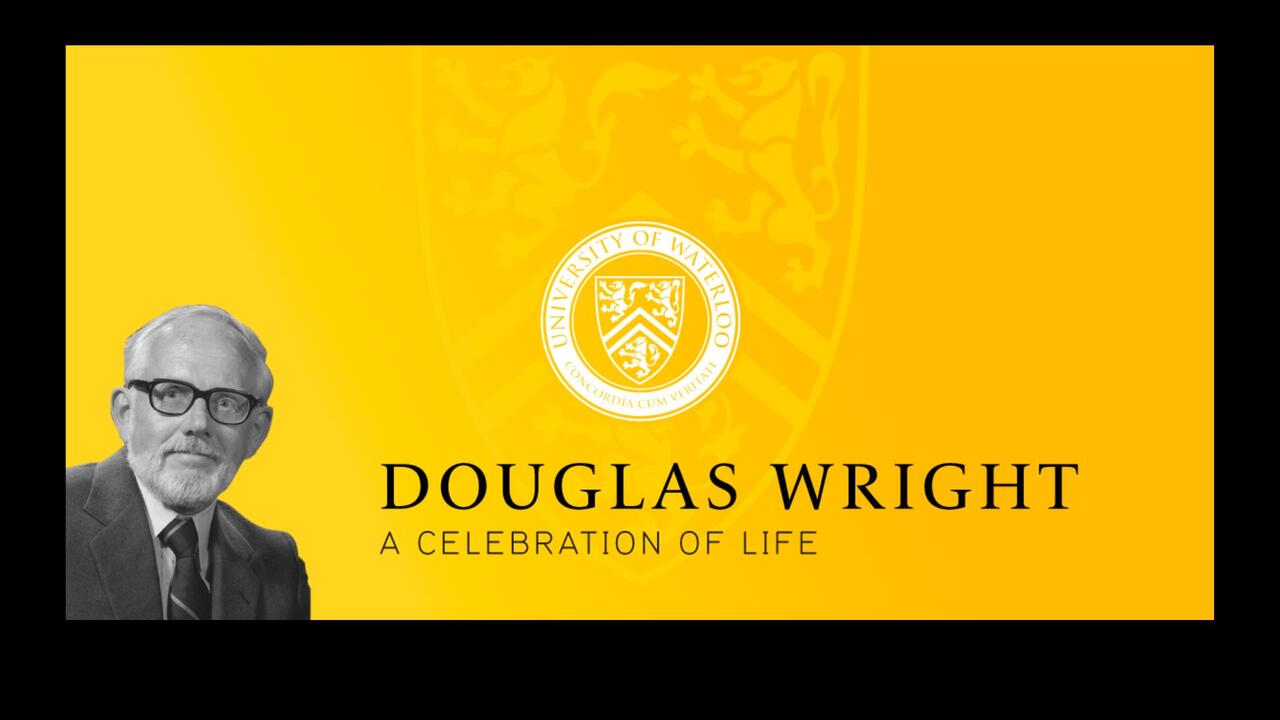
Waterloo celebrates the life and legacy of Douglas Wright
Former president and first dean of the Faculty of Engineering left lasting impact

Former president and first dean of the Faculty of Engineering left lasting impact
By University RelationsThe University of Waterloo celebrates the life and legacy of President Emeritus Douglas Tyndall Wright with a special event on September 23.
Wright, who served as the first dean of the Faculty of Engineering from 1958 to 1966 and as Waterloo’s third president and vice-chancellor from 1981 to 1993, passed away on May 21, 2020.
As his death occurred during the pandemic, the University was unable to properly mark his passing in a significant way.
In collaboration with the Wright family, Waterloo honours the legacy of Douglas Wright, his achievements and how he shaped the University’s future at a special Celebration of Life event. The in-person event is also available to view on YouTube.
The special event features remarks and tributes from President and Vice-Chancellor Vivek Goel, dean of engineering Mary Wells and other university leaders, former colleagues and students, distinguished community leaders and members of the Wright family. The event also includes live music and video tributes.
“President Wright’s vision and drive from the very outset of Waterloo’s existence in 1958 helped propel us to where we find ourselves today,” Goel says. “While we mourn the loss of an extraordinary visionary, leader and educator, we can also celebrate his lasting impact on the University of Waterloo.”
Wright played a major role in moving the University into a whole new level of applied knowledge, patents and technology transfer.
Major computer companies saw the advantage of supporting the University by providing equipment and research dollars. For example, Digital Equipment’s $24 million donation bought eight new VAX machines that made it possible to computerize both the Oxford English Dictionary and develop the software, leading to the creation of Waterloo spinoff successes MapleSoft and OpenText.
He left a teaching position at Queen’s University to join a young upstart University of Waterloo in 1958 as the first chair of civil engineering. He soon became the first dean of engineering. While he was dean, Waterloo became the largest undergraduate engineering school in the country.
A brief history of Douglas Wright's influences on the University of Waterloo, narrated by Brandon Sweet.
Wright left the University for a post at Queen’s Park. He became a deputy minister in 1967 with responsibilities initially for university financing, and subsequently, for social policy with the Cabinet Committee for Social Development.
In 1969, in response to concern about the mounting provincial costs for university education, the Honourable William Davis, then minister of education, put Wright in charge of the province’s Committee on University Affairs. Wright chaired the Commission on Post-Secondary Education in Ontario. From 1979 to 1980, he was deputy minister of culture and recreation.
He came back to the University of Waterloo as president, and would lead it for nearly 12 years, throughout the 1980s and early part of the 1990s.
“His return to Waterloo as our third president signalled a return to the no-holds-barred restlessness and momentum of the founding years,” said Ken McLaughlin, historian and author. “He pushed, prodded and pulled us with him as he pursued academic excellence and social relevance.”
Ken McLaughlin, historian and distinguished professor emeritus, discusses the lasting impact of Doug Wright with Pamela Smyth on the Beyond the Bulletin podcast.

Read more
Brigette Lau (BASc '99) created Firework Ventures because we all deserve a fulfilling career and life — and she believes that tech can help

Read more
New council builds community for alumni from the last decade

Read more
Engineering student impresses judges with carbon-neutral masonry units formed using bacteria
The University of Waterloo acknowledges that much of our work takes place on the traditional territory of the Neutral, Anishinaabeg, and Haudenosaunee peoples. Our main campus is situated on the Haldimand Tract, the land granted to the Six Nations that includes six miles on each side of the Grand River. Our active work toward reconciliation takes place across our campuses through research, learning, teaching, and community building, and is co-ordinated within the Office of Indigenous Relations.